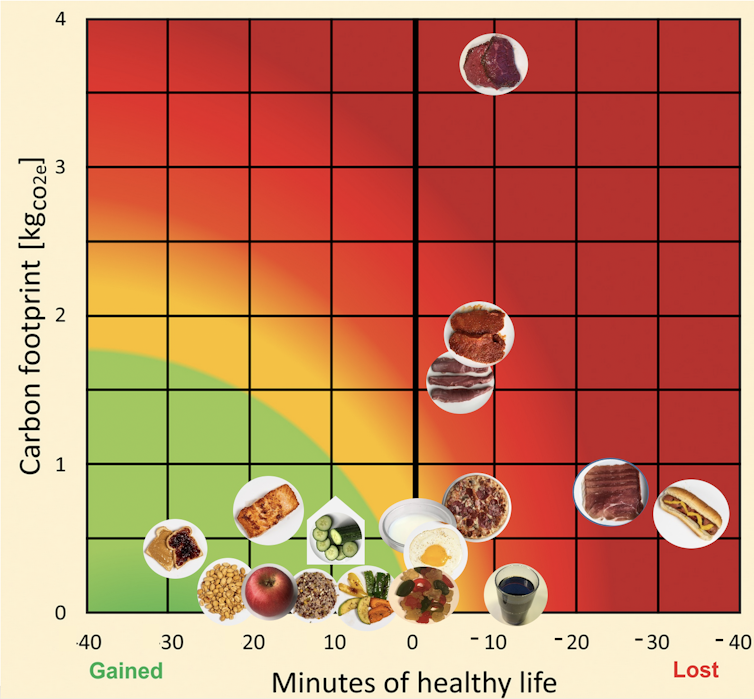Health Nutritional Index : Hotdog, Anyone?
"For example, we found that, on average, 0.45 minutes are lost per gram of any processed meat that a person eats in the U.S.""The 61g of processed meat in a hotdog sandwich results in 27 minutes of healthy life lost due to this amount of processed meat alone. Then, when considering the other risk factors, like the sodium and transfatty acids inside the hotdog -- counterbalanced by the benefit of its polyunsaturated fat and fibres -- we arrived at the final value of 36 minutes of healthy life lost per hotdog."Study, published in journal Nature Food"The urgency of dietary changes to improve human health and the environment is clear.""Our findings demonstrate that small targeted substitutions offer a feasible and powerful strategy to achieve significant health and environmental benefits without requiring dramatic dietary shifts."Professor Olivier Jolliet, University of Michigan"Previous studies have often reduced their findings to a plant vs animal-based foods discussion.""Although we find that plant-based foods generally perform better, there are considerable variations within both plant-based and animal-based foods."Katerina Stylianou, study lead author

Food and environmental experts at University of Michigan released a study, published in the journal Nature Food, focusing on a standardized method of assessing the carbon footprint and nutritional impact of close to 6,000 different foods. The method of calculation is set out by their Health Nutritional Index through which the health burden of a gram of food is calculated and scaled to a standard serving size. The study authors also wrote an article which was published in The Conversation, to explain their rationale, reasoning and recommendations.
Minutes -- it would seem of a lifespan -- can be extended when nutritional and problem-free foods are eaten, such as a portion of nuts which, according to the Index, adds close to 25 minutes. In the calculation process, a peanut butter and jam sandwich offers over half an hour of extra life. Really! According to the researchers a peanut butter and jam sandwich turned out the best example of food to extend lifespan, reflecting the high nut content; the nuts, the researchers adding, outweighing any negative aspect of consuming peanut butter.
A unique equation is attributed to each item of food so that studying the entries and their qualifications there is no requirement to commit to a wide dietary change, according to the researchers. Should a meat eater wish to replace ten percent of their daily calories -- 250 for men and 200 for women -- with nuts, fruits and vegetables instead of processed meat or beef, there would result a gain of 48 minutes of healthy life each time that exchange is committed to.
 |
| Eating a hot dog could cost you 36 minutes of healthy life, while choosing to eat a serving of nuts instead could help you gain 26 minutes of extra healthy life, according to a University of Michigan study. |
And then there are the environmental benefits to be considered in following the recommended exchanges where an individual can reduce their daily dietary carbon footprint by a third. The purpose of scaling back problematic food and ramping up approved foods to fill the gap targets a healthy life expectancy; the length of time an individual can enjoy a good quality of life while remaining disease-free.
All aspects of a food product's life cycle, from harvesting, production, processing, consumption and waste disposal along with its nutritional value or detriments are taken into account through the Health Nutritional Index. Each food was given a traffic-light rating in the Index, where for example salmon scored well for nutrition adding 16 minutes to a healthy life, but failed for its environmental impact, therefore not recommended.
"The green zone represents foods that are recommended to increase in one’s diet and contains foods that are both nutritionally beneficial and have low environmental impacts. Foods in this zone are predominantly nuts, fruits, field-grown vegetables, legumes, whole grains and some seafood.""The red zone includes foods that have either considerable nutritional or environmental impacts and should be reduced or avoided in one’s diet. Nutritional impacts were primarily driven by processed meats, and climate and most other environmental impacts driven by beef and pork, lamb and processed meats."Michigan News, University of Michigan
As another example of a food good for health but problematic for the environment, Chili con carne with beans rates as well in that category. Yet there are some food consumers who will be pleased to see, riffling through the entries in the Index that cola, while deserving a red (fail) for nutrition, removing 12.5 minutes of life per drink, receives a green for environmental impact.
- Decreasing foods with the most negative health and environmental impacts including high processed meat, beef, shrimp, followed by pork, lamb and greenhouse-grown vegetables.
- Increasing the most nutritionally beneficial foods, including field-grown fruits and vegetables, legumes, nuts and low-environmental impact seafood.
 |
| Eating a hot dog could cost you 36 minutes of healthy life, while choosing to eat a serving of nuts instead could help you gain 26 minutes of extra healthy life, according to a University of Michigan study. |
Labels: Nutrition vs Environment, Study

0 Comments:
Post a Comment
<< Home